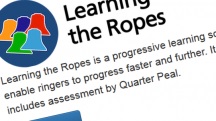Your place or mine?
Learners are introduced to the concept of their “place” in the row very early on since it’s so fundamental, but most beginners first come across the words “make places” as an exercise at LtR Level 2. When you learn to hunt you realise that you’re making places both at the front and at the back. When you start to learn methods, you learn about making places such as seconds in Plain Bob, thirds in Grandsire, and fourths when you “make the bob” in Plain Bob. I’m going to give you some tips for each of these situations in turn.
“Making places” is an exercise in bell control. You exchange place with the bell next to you, either going up or down a place for two blows before returning to your starting place for two blows, and then repeating it.This can be either hand and back, or back and hand – you need to be able to do both, comfortably and accurately. At LtR Level 1 you’ll have been introduced to how to change speed: catch the sally early (higher) to pull in at handstroke or move up the tail to shorten the rope to pull in at backstroke, or “floating” the handstroke nearer to the balance or letting out rope to ring later at backstroke. Making places requires you to do this repeatedly, with a blow at rounds speed in between alternate faster and slower blows. The fact that it’s repeated will help you to learn how to anticipate what’s coming, and you can use this to learn to ring with less effort.
First of all, get your bell handling right. Don’t ring “short armed”, but fully extend your arms at the top of every stroke. Instead of your muscles taking the strain, the elasticity in your tendons will help to recover and re-use energy from the bell at the top of the stroke, and if you can anticipate the next stroke, you can use your muscles more efficiently and still ring accurately. So, if you need to pull in, don’t pull the previous stroke quite so hard (so you’re not working against yourself); and if you need to ring later, pull the previous stroke a tiny bit harder (or longer, for a backstroke) so that the bell stays up more easily.
Next, hearing your own bell strike is important. It’s the only way you’ll know whether you’re in exactly the right place. Learn to pick out which bell is yours in the row, even as you change place. Many people like to say their place to themselves as they’re ringing: “3rd, 3rd, 4th, 4th, 3rd, 3rd, 4th, 4th”, for example. Try to keep the blows sounding at an even rhythm in each row; your changes should introduce no gaps or clashes.
Now let’s look at Plain Hunt. You ring two blows when you’re leading and two blows at the back, a bit like making places, but you only ring once in each place everywhere in between. At first you will probably concentrate on hunting evenly up and down, ringing slower or faster as needed. The places, especially the second blows (which are at Rounds speed), often don’t receive much attention, but if you’ve learnt to count your place as you go, and you can hear when your bell strikes, you should be able to notice these blows too. Get the handstroke lead gap right and make sure there is no gap at backstroke, just as you would do when leading in Called Changes. At the back it’s very common not to get the bell high enough: listen for any “clipping” with the bell below you and aim to get even spacing on both blows here, too.
Finally, a look at making places in methods. If you’re hunting – to either 2nd, 3rd or 4th place and back – the bells you pass on the way out will be the ones you’ll pass again on the way back to lead. Once you get to your last place you don’t need to look for any others: they’re behind you in the row and cannot get past you while you’re making places, however many there are (such as long thirds at a Grandsire single). Many learners look for another bell that they don’t need, and then stumble when they don’t see it. Don’t make that mistake, but do keep listening; the change of rhythm should not introduce gaps or clashes.

Mike Rigby, ART Teacher and Tower Captain at Lighthorne, Warks